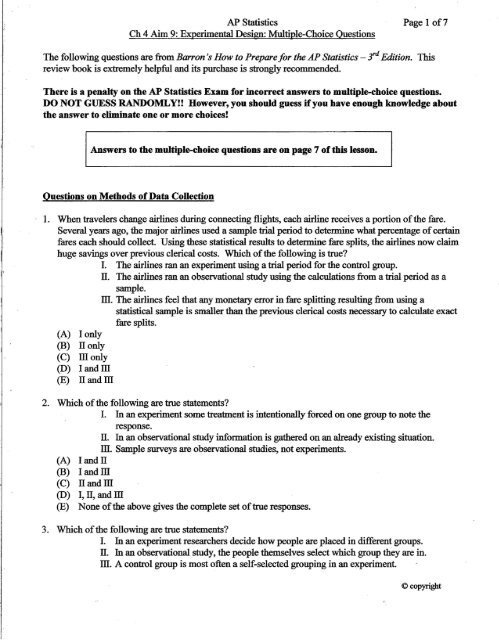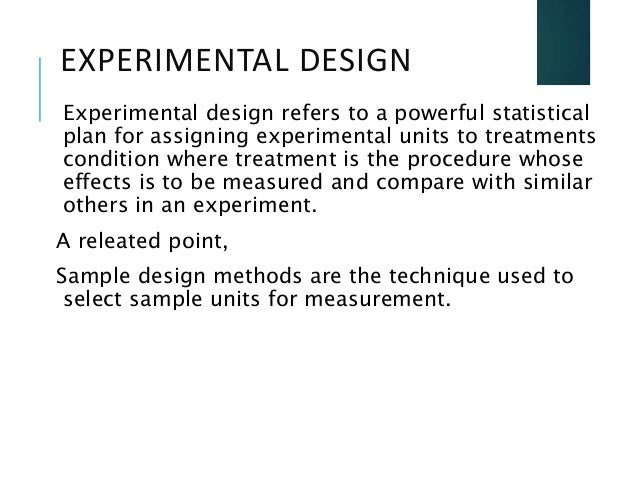Table Of Content

Designs with more than one independent variable are considered next. Factors might include preheating the oven, baking time, ingredients, amount of moisture, baking temperature, etc.-- what else? You probably follow a recipe so there are many additional factors that control the ingredients - i.e., a mixture. What parts of the recipe did they vary to make the recipe a success?
Table of contents
R. Rao introduced the concepts of orthogonal arrays as experimental designs. This concept played a central role in the development of Taguchi methods by Genichi Taguchi, which took place during his visit to Indian Statistical Institute in early 1950s. His methods were successfully applied and adopted by Japanese and Indian industries and subsequently were also embraced by US industry albeit with some reservations. One of the most important requirements of experimental research designs is the necessity of eliminating the effects of spurious, intervening, and antecedent variables. But there could be a third variable (Z) that influences (Y), and X might not be the true cause at all.
Step 2: Write your hypothesis
(PDF) Statistical analysis for single case data: Draft chapter - ResearchGate
(PDF) Statistical analysis for single case data: Draft chapter.
Posted: Sun, 24 Jan 2016 01:02:07 GMT [source]
A completely randomized design could, by chance, assign gasoline additive 1 to a larger proportion of cars from manufacturer 1. In such a case, gasoline additive 1 might be judged to be more fuel efficient when in fact the difference observed is actually due to the better engine design of automobiles produced by manufacturer 1. In this revised experiment, each of the manufacturers is referred to as a block, and the experiment is called a randomized block design.

Statistical control
In essence, a lurking variable is a third variable that is not measured in the study but may change the response variable. In this experiment, there are two treatments, and individuals are randomly placed into the two groups. Either both groups get a treatment, or one group gets a treatment and the other gets either nothing or a placebo. The group getting either no treatment or the placebo is called the control group. The idea of the placebo is that a person thinks they are receiving a treatment, but in reality they are receiving a sugar pill or fake treatment.
Experimental Designs – Lesson & Examples (Video)
If practice on this task leads to better performance, then it would appear that higher doses caused the better performance when, in fact, it was the practice that caused the better performance. In medical or social research, you might also use matched pairs within your between-subjects design to make sure that each treatment group contains the same variety of test subjects in the same proportions. You should also include a control group, which receives no treatment. The control group tells us what would have happened to your test subjects without any experimental intervention.
Similarly, in a study of blood pressure some subjects will have higher blood pressure than others regardless of the condition. Within-subjects designs control these individual differences by comparing the scores of a subject in one condition to the scores of the same subject in other conditions. This typically gives within-subjects designs considerably more power than between-subjects designs. That is, this makes within-subjects designs more able to detect an effect of the independent variable than are between-subjects designs. Three of the more widely used experimental designs are the completely randomized design, the randomized block design, and the factorial design. In a completely randomized experimental design, the treatments are randomly assigned to the experimental units.
Blind Study:
The same goes for studies with correlational design (Adér & Mellenbergh, 2008). When participation in a study prompts a physical response from a participant, it is difficult to isolate the effects of the explanatory variable. To counter the power of suggestion, researchers set aside one treatment group as a control group. This group is given a placebo treatment–a treatment that cannot influence the response variable. The control group helps researchers balance the effects of being in an experiment with the effects of the active treatments.
Step 3: Design your experimental treatments
An advantage of within-subjects designs is that individual differences in subjects' overall levels of performance are controlled. This is important because subjects invariably will differ greatly from one another. In an experiment on problem solving, some subjects will be better than others regardless of the condition they are in.
In 1950, Gertrude Mary Cox and William Gemmell Cochran published the book Experimental Designs, which became the major reference work on the design of experiments for statisticians for years afterwards. Multilevel modeling is used to analyze data that is nested within multiple levels, such as students nested within schools or employees nested within companies. Time series analysis is used to analyze data collected over time in order to identify trends, patterns, or changes in the data. Field experiments are conducted in naturalistic settings and allow for more realistic observations. However, because field experiments are not as controlled as laboratory experiments, they may be subject to more sources of error. Laboratory experiments are conducted under controlled conditions, which allows for greater precision and accuracy.
By randomly selecting participants and using statistical techniques to analyze the data, researchers can make inferences about the larger population with a high degree of confidence. This involves dividing participants into subgroups or blocks based on specific characteristics, such as age or gender, in order to reduce the risk of confounding variables. Additionally, a useful and particular case of a blocking strategy is something called a matched-pair design. This is when two variables are paired to control for lurking variables. A double-blind experiment is when both the subjects and investigator do not know who receives the placebo and who receives the treatment.
In this experiment, subjects diagnosed as having attention deficit disorder were each tested on a delay of gratification task after receiving methylphenidate (MPH). All subjects were tested four times, once after receiving one of the four doses. Since each subject was tested under each of the four levels of the independent variable "dose," the design is a within-subjects design and dose is a within-subjects variable. Within-subjects designs are sometimes called repeated-measures designs. A computational procedure frequently used to analyze the data from an experimental study employs a statistical procedure known as the analysis of variance. For a single-factor experiment, this procedure uses a hypothesis test concerning equality of treatment means to determine if the factor has a statistically significant effect on the response variable.

No comments:
Post a Comment